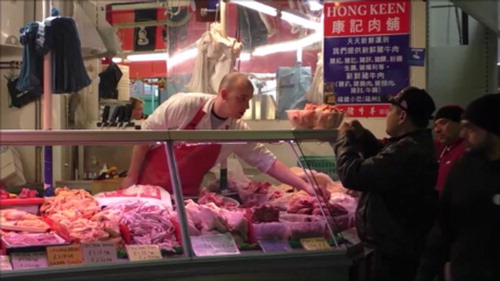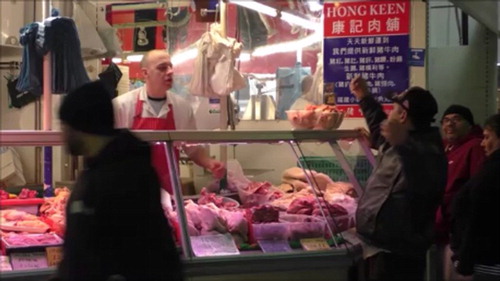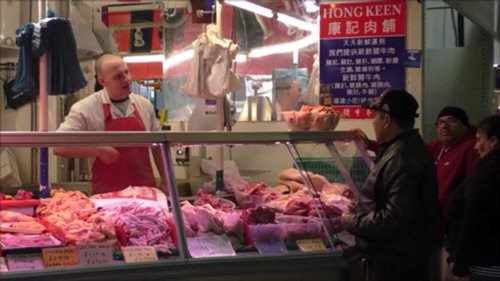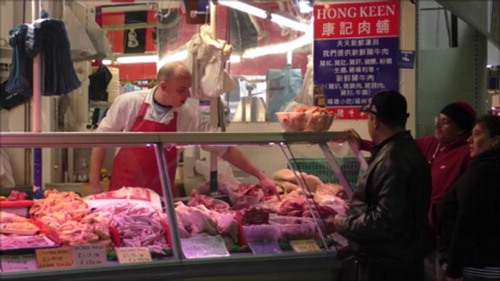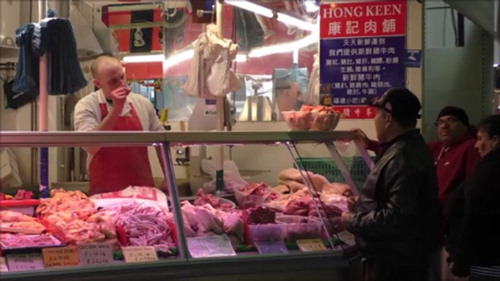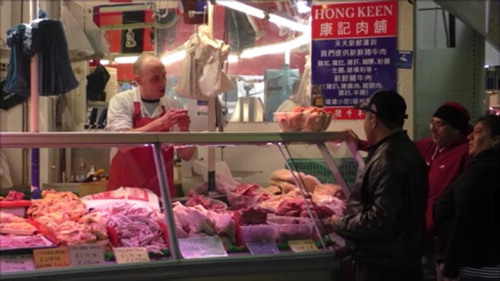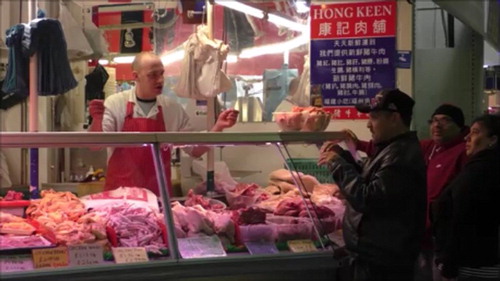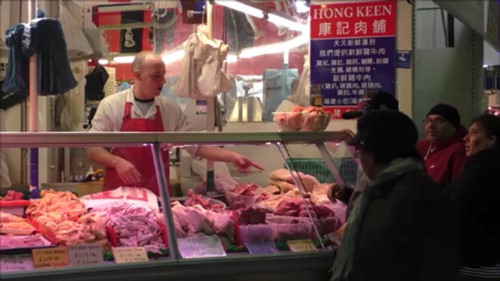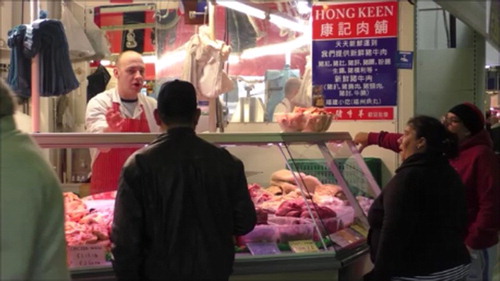ABSTRACT
This article reports communicative interactions with a focus on the body as a dimension of the semiotic repertoire. The research context is a four-year, multi-site linguistic ethnography which investigates how people communicate in superdiverse cities in the UK. In the setting of a butcher’s stall in a city market we consider three interactions at a particular market stall between butchers and their customers. In the first, gesture is deployed as a resource by both an English butcher’s assistant and his customer. In the second, we examine the body as a resource in the semiotic repertoire of a Chinese butcher as he negotiates a faux haggling interaction with East European customers. In the third example, also recorded as field notes, a Chinese woman employs a ‘Chinese’ gesture to represent the number of pieces of offal she wishes to purchase from an English butcher’s assistant. Each of the examples was recorded during an extended period of ethnographic field work in Birmingham Bull Ring market. Through detailed analysis of these interactions we argue that when people’s biographical and linguistic histories barely overlap, they translanguage through the deployment of wide-ranging semiotic repertoires.
1. Introduction
Translanguaging refers to the communicative practices in which people engage as they bring into contact different biographies, histories, and linguistic backgrounds. Translanguaging has the potential to be transformative and creative, as it can transcend apparent difference, enabling people to communicate with whatever resources are available to them, rather than constraining them within prescribed limits. Translanguaging therefore has a spatial dimension, as it occurs in a ‘translanguaging space’ (Wei, Citation2011), or ‘translanguaging zone’ (Blackledge, Creese, & Hu, Citation2016a). Translanguaging also has an ideological dimension, as it is contingent on local attitudes to, and beliefs about, communicative practice. Attitudes and beliefs related to communication are not fixed, and may be changed within, and by, the communicative interaction itself. In this paper, however, we propose to focus specifically on the corporeal dimension of translanguaging. That is, we will examine interactions between people as they come into contact in a busy meat market in the superdiverse city, and consider how the body is put to work in the process of communication. In common with Kusters, Spotti, Swanwick, and Taipio (Citationin press), we find that studies of multimodal communication have tended to focus on monolingual settings, while studies of multilingualism and translanguaging have paid little attention to multimodality. In the contexts of a butcher’s stall in a city market we will analyse multilingual communicative interactions with a focus on the body as a dimension of the semiotic repertoire. We will consider three interactions at a particular market stall between butchers and their customers. In the first, which was video-recorded, gesture is deployed as a resource by both an English butcher’s assistant and his customer. In the second, recorded in observational field notes, we examine the body as a resource in the semiotic repertoire of a Chinese butcher as he negotiates a faux haggling interaction with East European customers. In the third example, also recorded as field notes, a Chinese woman employs a ‘Chinese’ sign to represent the number of pieces of offal she wishes to purchase from an English butcher’s assistant. Each of the examples was recorded during an extended period of ethnographic field work in Birmingham Bull Ring market. Through detailed analysis of these interactions we are able to argue that when people’s biographical and linguistic histories barely overlap, they translanguage through the deployment of wide-ranging semiotic repertoires.
2. Translanguaging
Otheguy, García, and Reid (Citation2015, p. 281) define translanguaging as ‘the deployment of a speaker’s full linguistic repertoire without regard for watchful adherence to the socially and politically defined boundaries of named (and usually national and state) languages’. García and Leiva (Citation2014) argue that bilingual families and communities translanguage in order to construct meaning. They further propose that what makes translanguaging different from other fluid languaging practices is that it is transformative, with the potential to remove the hierarchy of languaging practices that deem some more valuable than others. Translanguaging, they argue, is about a way of being, acting, and languaging in social, cultural, and political contexts (Citation2014).
Wei (Citation2011, p. 1223) makes a similar argument that the act of translanguaging ‘creates a social space for the multilingual language user by bringing together different dimensions of their personal history, experience and environment’. Translanguaging leads us away from a focus on ‘languages’ as distinct codes to a focus on the agency of individuals engaged in using, creating, and interpreting signs for communication. Noguerón-Liu and Warriner (Citation2014) suggest that the notion of translanguaging expands existing theories of multilingualism by focusing on the social practices of individuals. They adopt this term to move away from a focus on abstract, idealised notions of ‘a language’ as a set of skills, and to emphasise the fact that multilingual people deploy a variety of resources while engaging in everyday practice.
García and Wei (Citation2014) point out that translanguaging differs from code-switching in that it refers not simply to a shift or a shuttle between two languages, but to the speakers’ construction and use of original and complex interrelated discursive practices that cannot be easily assigned to one or another traditional definition of a language, but that make up the speakers’ complete semiotic repertoire. Translanguaging starts from the speaker rather than the code or ‘language’, and focuses on empirically observable practices. Translanguaging practices are not viewed as marked or unusual, but are rather taken to be the normal mode of communication that characterises communities throughout the world. A translanguaging lens proposes that, rather than making decisions about which ‘language’ to use in a particular social setting, people have a semiotic repertoire from which they select resources to communicate.
3. Semiotic repertoires
Kusters et al. (Citationin press) point out that communicative repertoires are inherently multimodal, and so we should refer to semiotic repertoires rather than linguistic repertoires. Semiotic repertoires include but are by no means limited to the linguistic. Rather, they include aspects of communication not always thought of as ‘language’, including gesture, posture, and so on; they are a record of mobility and experience; they include gaps and silences as well as potentialities; and they are responsive to the places in which, and the people with whom, semiotic resources may be deployed (Blackledge, Creese, & Hu, Citation2015). The way people walk, stand, and sit, the way they tilt their head, the gaze of their eyes, the shrug of their shoulders, the movement of their hands and fingers, their smile or frown, all are part of the semiotic repertoire. The integrated nature of the semiotic repertoire is fundamental. Embodied communicative practice is not in any way separate from linguistic communicative practice. They are integral to each other to the extent that they are one and the same.
Encounters between people are characterised by what Goffman (Citation1963) calls the ‘body idiom’ – dress, bearing, movement, position, and physical gestures. During face-to-face interaction participants are present to each other as living physical bodies in a particular situation. Gesture is a typical feature of the semiotic repertoire. Sometimes gesture is essential to the speech it accompanies, and at other times it is less essential. In some instances gesture is made particularly salient, as in the marketplace when a customer points to a display of pigs’ hearts and holds up six fingers (Blackledge et al., Citation2015). Furthermore, gesture may be more than a simply visual phenomenon (Goodwin, Citation1986/Citation2009). A handclap, for example, contributes sound to the communicative interaction. In other instances a gesture may be extended to attract attention through touch. Goodwin proposes that gesture plays a key role in the complex organisation of the access participants have to each other’s bodies as visible phenomena within interaction. Gesture may be used to organise, dismantle, and re-assemble the spatial configuration of an interaction. It provides a resource for negotiating features of the moment-by-moment organisation of the interactive processes within which it emerges. Gesture is not simply a way to display meaning but an activity with distinctive temporal, spatial, and social properties that participants not only recognise but actively use in the organisation of their interaction (Goodwin, Citation1986/Citation2009, p. 47).
McNeill (Citation1985, p. 351) pointed out that gestures are verbal. That is, ‘the whole of gesture and speech can be encompassed in a unified conception’, and to separate them is an artificial process. Kendon (Citation2004) proposes that gesture is visible action used as an utterance or part of an utterance, where ‘utterance’ refers to an intentional communicative move. Gesture is often integrated with speech in such a way that it must be taken into account in any full understanding of communicative encounters. Norris (Citation2004) points out that commonly a participant in an interaction employs hand/arm gestures when speaking, and gesturing starts slightly earlier than the words expressing the same idea. Norris suggests that it is not useful to separate these kinds of gestures from the language with which they co-occur. She distinguishes between four types of gesture: iconic, metaphoric, deictic, and beat gestures. Iconic gestures depict pictorial content and mimic what the individual wants to communicate verbally. Metaphoric gestures may also depict pictorial content, but they portray abstract ideas or categories. Deictic gestures often point to objects in the physical world, but they can also point to events in the past or the future, or point to ideas and notions as if they had a physical location in the world. Beat gestures refer to the movement of hands/arms up and down, or back and forth. However, we cannot assume that when people encounter each other in the absence of a spoken language in common gestures will inevitably serve as a universally understandable ‘lingua franca’. In fact in Birmingham Bull Ring market we observed instances, reported elsewhere (Blackledge et al., Citation2015; Blackledge, Creese, & Hu, Citation2016b), in which an elderly Chinese woman’s attempt to purchase lamb through the deployment of gesture resulted in her feeling humiliated and angry after a team of butchers mocked her attempts to communicate. It was clear that although (as we shall see) gesture and other embodied communicative actions were routinely deployed in encounters between people in the market hall, such encounters were by no means uniformly successful.
Scollon and Wong Scollon (Citation2004) refer to the ‘historical body’, the product of historical practice, of what Bourdieu (Citation2000, p. 145) termed a group’s ‘ways of being and doing’. The historical body, or habitus, is a learned system of dispositions. Scollon and Wong Scollon (Citation2004) define the historical body as people’s ‘life experiences, their goals and purposes, and their unconscious ways of behaving and thinking’ (p. 46). Whenever people enter into social action, they bring along their own biographies. Each participant enters a social situation carrying an already established biography of prior dealings with the other participants – or at least with participants of their kind, and enters also with a vast array of cultural assumptions presumed to be shared (Goffman, Citation1983, p. 4). That is, interactants bring to each exchange their ‘historical body’. Historical bodies have been formed in particular social spaces and they represent the communicative competence of people in such social spaces (Blommaert & Huang, Citation2010).
Bourdieu referred to the phenomenon of the historical body as habitus. Scollon and Wong Scollon (Citation2004, p. 13) ‘prefer historical body because it situates bodily memories more precisely in the individual body’. For Bourdieu habitus, the product of a historical acquisition, is the ‘deep-rooted dispositions of the bodily hexis’ (Citation1991, p. 88), rooted in posture, ‘a way of bearing the body’ (Citation2000, p. 144), that articulates a more-or-less unconscious sense of ‘how to be’ and ‘how to behave’ in a social arena. Scollon and Scollon similarly propose that ‘a lifetime of personal habits come to feel so natural that one’s body carries out actions seemingly without being told’ (Citation2004, p. 13). Bourdieu argued that the habitus
ensures the active presence of past experiences, which, deposited in each organism in the form of schemes of perception, thought and action, tend to guarantee the ‘correctness’ of practices and their constancy over time, more reliably than all formal rules and explicit norms. (Citation1990, p. 54)
Lefebvre (Citation1974/Citation1991) argued that social practice presupposes the use of the body: the use of the hands, members and sensory organs, and the gestures of work. Lefebvre considered that to belong to a given society or group (in our case at minimum the ‘society’ of market traders, and of the city) is to know and use its codes for politeness, courtesy, affection, parley, negotiation, and so on. Gestural systems, he said, embody ideology and bind it to practice. Through gestures, ideology performs actions. Organised gestures are not simply performed in a physical space, in the space of bodies. Bodies themselves generate spaces, which are produced by and for their gestures. Social spaces are given rhythm by the gestures which are produced within them, and which produce them. This is true of the meat market. Certain gestures (a ‘chopping’ gesture with the hand; three fingers held up; a raised thumb; a finger dragged across a throat; a finger pointing) produce the social space of the market, and produce its rhythm. But Lefebvre made it clear that gestures cannot be attributed to nature: ‘They are acquired, are learned’ (Citation1992/Citation2015, p. 47). That is, the repeated gestures which serve as resources in the semiotic repertoires of the market are far from arbitrary. Rather, they are learned, both in the specific interactions of this market, and of a particular stall, but also as generic practices in markets elsewhere. They are features of the brief relationships which come into being, are negotiated, and are concluded, in a service encounter.
We began by pointing out that translanguaging has a spatial dimension and an ideological dimension. Notwithstanding our focus on the embodied dimension of translanguaging in this paper, we keep in view the ideological and the spatial. Language ideologies are sets of beliefs about, attitudes to, and practices of language (Kroskrity, Citation2004). As such language ideologies are key dimensions of semiotic repertoires. Local language ideologies may be constraining or enabling forces in opening up space in which certain communicative practices may be realised. Linked to the ideological dimension of translanguaging is the spatial dimension. Some forms of embodied communication are acceptable, that is, are normative, in the meat market, but not in (say) the city library or the local bank. These distinctions are determined both spatially and ideologically. Pennycook and Otsuji (Citation2015) understand repertoire as resources available at a point in time and space. They propose that by taking this approach we can start to envisage an interaction between the resources brought to the table by individual trajectories (with all the social, historical, political, economic, and cultural effects this may entail) and the resources at play in a particular space. Pennycook and Otsuji (Citation2015) expand the notion of repertoire to the more extensive dynamic between language and urban space (‘spatial repertoires’), and link the repertoires formed through individual life trajectories to the particular spaces in which these linguistic resources are deployed. Spatial repertoires draw on individual as well as other available resources, while individual repertoires contribute to and draw from spatial repertoires. In the following examples, we will suggest that when people whose linguistic backgrounds minimally overlap come into contact they deploy semiotic repertoires which include a wide range of signs for making meaning. We propose that in communicating with resources available at particular times and in particular spaces, they do not separate the linguistic from the embodied, but make meaning through repertoires of signs which integrate verbal and non-verbal action.
4. Translanguaging and the body
Markets are places where we encounter difference. More than any other city spaces, they define human engagement with difference, with different people, different clothes, different goods, and different ways of speaking (Pennycook & Otsuji, Citation2015). Markets offer ‘an ideal setting to explore the relationship between economy and society, especially when we consider the ways that these markets reflect, but also shape, the nature and meaning of social and cultural diversity’ (Hiebert, Rath, & Vertovec, Citation2015, p. 16). They entail encounters between people, frequently across lines of social and cultural difference. For some people street markets are the primary means by which they encounter people from other backgrounds. Watson (Citation2009a, p. 1577) argues that markets represent a much neglected public space and site of social connections and interaction in cities. She points out that they have been subject to surprisingly limited analysis to date. Watson (Citation2009b) argues that the sociocultural context of markets warrants textured investigation to make sense of when, where, and how encounters across difference occur productively or antagonistically, or somewhere in between. Hiebert et al. (Citation2015) ask whether the ‘spatial concentration of diversity’ (p. 17) in a marketplace inevitably contributes to cosmopolitan attitudes and identities. They argue that diversity shapes markets, and markets shape diversity. Markets also contribute to the configuration of social life. They reflect the basic sociocultural and socio-economic diversity of local areas, bringing people together into a public arena who might otherwise remain apart. This happens, say Hiebert et al., in settings that are both relatively controlled through ‘rules of engagement’, and also highly adaptive and dynamic. Markets offer particularly rich seams for social research because they ‘exemplify the global process of space-time compression, juxtaposing people with backgrounds from distant places and distinct cultures together in the same place’ (Hiebert et al., Citation2015, p. 17). They also offer sites at which embodied communication comes plainly into view.
The examples we present in this paper were generated as part of a four-year project funded by the Arts and Humanities Research Council, ‘Translation and Translanguaging. Investigating linguistic and cultural transformations in superdiverse wards in four UK cities’. The multi-site ethnographic project is directed by Angela Creese. The aim of the project is to investigate how people communicate when they bring different histories, biographies, and trajectories to interaction. The research was conducted across four cities in the UK: Birmingham, Cardiff, Leeds, and London. Sixteen sites were identified as places where people meet and come into contact, and where in the course of this contact they were likely to engage in communicative practices. The research sites included shops, market stalls, libraries, community centres, advice bureaux, and sports clubs. In this paper, we focus on the Birmingham section of the study. In each city ward research teams took as one of their points of departure the National Census of 2011, indicating which languages other than English were reported to be most commonly spoken in that ward. In selecting key participants for ethnographic research, the teams started with particular languages or groups of languages. Census 2011 (ONS) indicated that in the selected Birmingham ward, Ladywood, ‘Chinese languages’ were reported to be the most commonly spoken languages other than English. In this paper, we discuss one of the research sites: Birmingham Bull Ring market. Over a period of four months, researchers (Adrian Blackledge and Rachel Hu) observed the communicative practices of key participants at a butcher’s stall in the city meat market. The researchers wrote around 100,000 words of observational field notes, made 35 hours of workplace audio-recordings and video-recordings, made 30 hours of home audio-recordings, took more than 200 photographs, collected online, digital, and social media material, and conducted interviews with market stall holders.
The key participants were Kang Chen and Meiyen Chew, a couple who were the proprietors of a butcher’s stall. Kang Chen was originally from Changle in Fujian, in the South of China. He had arrived in the UK in 2001. Meiyen Chew was from Furong, Malaysia, and her family had moved to Malaysia from China in the 1930s. Meiyen Chew had come to the UK with her sister in 2002. A third de facto key participant was Bradley, an English butcher’s assistant who had been working on the same stall for nearly two years at the time of the study. Bradley, like Kang Chen and Meiyen Chew, wore a digital audio-recording device at times during the period of observation.
It was immediately evident to the research team that a significant feature of the semiotic repertoires of both market traders and their customers was the body. Customers would regularly point to the produce they wished to purchase. They used physical gestures to order their meat and offal – a man touched his own tongue when he wanted ox tongue; a man pointed to his own head when he wanted to buy pig’s head; a woman tapped her thigh to indicate leg of lamb. Traders and customers held up fingers to indicate numbers, quantities, or prices; they raised their thumbs to indicate assent; elaborate mimes represented chickens or pigs. Gesture, mime, and physical performance were part of the spatial repertoire of the market hall, and a feature of the orders of discourse (Blackledge et al., Citation2016b). This is not, of course, to suggest that gestures and other non-verbal actions can unproblematically or inevitably mediate between interactants who do not share a spoken code. In what follows, we present three brief examples of encounters in which individuals draw on multimodal resources, deploying semiotic repertoires of available signs as best they can to make meaning.
4.1. Example 1
In the first example, a customer approached the butcher’s stall, where Bradley, the English assistant butcher, was ready to serve. Bradley was wearing an audio-recording device. The customer intended to buy pig’s small intestine. In the transcript, notes in the fourth column refer to action. Images follow the transcript, and are referenced in column 5.
[Bradley (BJ); customer (C1)]
A customer approaches the stall and Bradley (BJ), the butcher’s assistant, realises that the customer wants to buy pig’s small intestine. Bradley explains to the customer that although the butchers once sold this item, they are no longer able to do so. Bradley and the customer negotiate mainly by means of iconic gestures which represent the large and small intestine, by deictic gesture, and through speech. The customer asks the butcher a question by saying ‘is it this erm?’, as he does so representing the small intestine with a gesture made by opening his arms wide (), bringing his hands together (), and opening his arms wide again (). In response, Bradley points to his own stomach to represent the intestine (), and then points to the pig’s large intestine (), which is displayed on the counter. With reference to the large intestine, Bradley makes a gesture to represent ‘small’ with his finger and thumb (), and repeats the gesture of pointing to his own stomach to represent the intestine (). He shakes his right hand quickly from side to side to indicate a negative response. He then makes a gesture with his hands clasped to represent ‘the small one’ (). As he does so he says, ‘no no no you want the in- the small intestine don’t you no no, you want that one but the small one’. Next Bradley mimics the customer’s original gesture with arms apart to represent the small intestine (), and points to the large intestine, saying ‘not that one’ (). Finally he makes a shrug with his hands and then with his arms as he says ‘no more’ (). Although the customer was not successful in achieving his aim of purchasing the pig’s small intestine (and in fact the stall had recently been told it was no longer allowed to sell it except as dog food), this is not because the customer and the butcher do not share proficiency in a single language. In fact they are able to communicate quite well with their bodies, making gestures which index the objects about which they communicate.
Most gestures in the market refer to that which is evident on the stall, or at least close by. In this example, the interaction refers on both sides to a piece of offal which is notable by its absence. It is for this reason that the customer and the trader are pressed into the creative deployment of ‘a continuum of iconic and metaphoric gestures’ (Jaworski & Thurlow, Citation2009, p. 254). In these interactions, the participants reach an understanding through consensus which is achieved at least partly (and perhaps mainly) by ‘extra verbal means’ (Habermas, Citation1984, p. 86). We saw repeatedly that gesture was a key means of communication in the market. Rymes points out that communicative repertoire goes beyond the linguistic to include the collection of ways individuals use not only language but other means of communication (gestures, dress, posture, accessories) to function in the multiple communities in which they participate (Citation2014). She asks ‘Why not build relationships on the basis of shared non-linguistic cues?’. We saw that in the market commercial transactions were based on precisely such means. It is noticeable here that Bradley asks the second pair of customers (visible as onlookers in the images): ‘goya?’ (turn 11). We heard this word deployed by the butchers on the stall on many occasions. When we asked Meiyen Chew what it meant, she said it was a word she had learned from her East European customers. She said it means ‘pig’s stomach’. She told us that East European customers particularly like the product, as they can stuff it with minced pork for deep frying. She said she did not know how to spell the word, but she shared it with Bradley and Kang and all of them used it, ‘just like those English or foreigners saying nihao, zaijian in Chinese, we just use it so the customers know we have that product’. Bradley tries out the word not typically associated with his background. It appears that in these encounters Bradley is able to understand the needs of his customers because he has worked on this stall for more than two years, and he is able to anticipate what customers want, based on how they look and sound (what Blommaert & Varis, Citation2011, term their ‘emblematic features’). That is, the communicative repertoire in play here is not limited to visible and audible signs, but includes histories of interaction in this market hall. In the absence of such histories, the encounters would potentially be less successful.
4.2. Example 2
Adrian Blackledge wrote an observational field note as a group of customers approached the butcher’s stall. The interaction was not audio-recorded, as it occurred during the period of observation before audio-recording began:
Three young men of South-East European appearance arrive. The most confident of the three men wants to buy chicken. Bradley serves him. He asks how much for a chicken, and Bradley tells him. The customer says ‘biggest one’. Bradley picks a chicken and shows him. The customer says, ‘no, bigger one’, and Bradley selects another. The customer looks satisfied with the selection now, and he asks for another chicken. Bradley chooses another, and asks, using both words and a ‘cutting’ gesture with his hands, whether the man wants the feet and head cut off. The man initially says yes, then says, ‘no, only-’ and makes a ‘cut-throat’ sign with his left hand. As far as I can see Bradley chops off the feet of both chickens anyway. He bags the two chickens, and gives the bag to the customer. Now one of the other men in the group looks interested in buying something. Kang Chen gets interested. The customer points to chicken pieces, and asks ‘how much that?’. Kang Chen says ‘ten pounds one kilo, eighteen pounds two kilos’. There ensues haggling over the price, with the customer making a series of offers which Kang Chen flatly refuses, always with a smile on his face. Now all three of the customers are smiling, finding amusement in the attempted bartering. The customer says ‘one kilo’, then, almost immediately, ‘two kilo’. Bradley and Kang Chen bag up the chicken. Now Kang Chen says ‘any (xxx) for you?’. The word I don’t understand, or recognize, seems to refer to pork. Kang Chen shows the three men the trays of pork. They seem interested, but show Kang Chen a bag of pork they have bought earlier from another stall. Kang Chen says ‘how much that?’. They don’t immediately answer, so Kang Chen asks again. One of them says ‘three fifty’, and Kang Chen responds: ‘that must be pig’s head’. The three men leave, but within a minute they are back again, looking at the pork. Kang Chen says ‘cheap-cheap’ and the customers echo him, ‘cheap-cheap’. Kang Chen says ‘very good, no fat, no bone inside there’. While Kang Chen and Bradley are serving the three men they often smile broadly at each other, usually at something Kang Chen has said. This is all done in a friendly and more-or-less convivial way. Kang Chen continues to ask whether the men want anything more. One of them asks him how much he wants for all of the remaining chickens on the counter (there appear to be about half a dozen). After some thought he says ‘thirty-five’. The man holds out a twenty pound note. Kang Chen says ‘thirty five’. Still the man presents the single note. Kang Chen says ‘three, five’, very slowly and deliberately, holding up three fingers of his right hand and five of his left. The man again offers the twenty pound note. Kang Chen draws a three and a five in the air. Still the man offers the note. Now Kang Chen draws a three and a five on the inside of the glass counter. The man continues to present the twenty pound note. Kang Chen says ‘no, thirty five’. By this time the negotiation has become something of a performance, with smiles all round. The customer finally gives up and the group leaves, with Kang Chen looking over at us with a big grin on his face.
The interaction between the three customers and the butcher, Kang Chen, and his assistant, Bradley, falls into several sections. First, Bradley attends to the customers. On the whole when Kang Chen and Bradley were on the stall Kang Chen served more of the Chinese customers, and Bradley served those who did not appear to be Chinese. Kang Chen watches this interaction, and it is only when he believes that the group is going to add further purchases to their initial order that he participates actively (‘Kang Chen gets interested’). The next section of the interaction involves Kang Chen haggling with the customers over the price of chicken pieces and pork. A third section occurs after the men first leave the scene and then return, and decide to buy pork. A fourth section revolves around a negotiation over the cost of a large number of chickens.
In the first section, the butcher’s assistant, Bradley, serves the three men, one of whom asks for the ‘biggest’ chicken. Before he wraps the meat Bradley wants to know whether the customer wants the chicken’s heads and feet cut off. In asking the question Bradley uses ‘both words and a cutting gesture with his hands’. The cutting gesture is an ‘indexical’, signalling its object by pointing to it (Wortham & Reyes, Citation2015). When the customer initially agrees, but then wants to make it clear that he prefers only the head chopped off, Bradley introduces another gesture to represent his meaning. The customer’s metaphoric gesture (‘a cut-throat sign with his left hand’) is deployed not because he believes that Bradley has limited comprehension of his language, but probably because his language is not among the available orders of discourse here and now, and he is not confident that his limited English is comprehensible. The trader and the customer do not have a spoken language in common, but gesture will do as they communicate by whatever means possible. Gesture does not inevitably result in successful communication between people who do not share linguistic codes, however, and here part of the communicative interaction does not appear to proceed successfully (Bradley cut off the feet). Nevertheless, indexical signs begin to accumulate and establish gesture as relevant social action.
In the second section (from ‘Kang Chen gets interested’ to ‘that must be pig’s head’), Kang Chen involves himself in selling to the three customers. One of them points to chicken pieces and asks ‘how much that?’. The butcher tells them and, in doing so, indicates his policy that the more you buy, the better the price. The social practice of haggling over the price of goods is typical in the market. Kang Chen refuses to cede ground to the customer, but the interaction is convivial, with smiles all round. The smiles of both the butcher and his customers are examples of ‘everyday metacommentary’ (Rymes, Citation2014, p. 1), as they are deployed as a means of sharing the protagonists’ understanding that they are engaged in a negotiation: ‘Now all three of the customers are smiling, finding amusement in the attempted bartering.’ The smiles are comments on communication, acknowledgements that the customer is trying it on, and the trader is having none of it. They signal an understanding of the social action in play, by pointing to its communicative value (Rymes, Citation2014, p. 11). If the customers’ attempt to knock down the price fails, nothing is lost. This is understood by all, and the attempt is a source of amusement. The field note is almost inevitably a further level, or layer, of metacommentary, as Blackledge’s note comments on the smiles which comment on the haggling interaction. Having completed the sale of two kilos of chicken pieces without reducing the price, Kang Chen asked the customer whether he would also like to buy pork. This is a typical strategy for this butcher: he would regularly ask his customers to top up their purchase in some way. Kang Chen adopts a translanguaging strategy here, deploying a word for ‘pork’ which he thinks will be familiar to the customers. Although he does not know for sure where they are from, he makes a snap assessment and tries out a word which acts as an indexical, pointing to his willingness to communicate on their terms, and to meet them in their linguistic territory. It is not clear whether they understand the term, as Kang Chen also physically shows the men the pork. When the customers show him (again showing rather than telling) they have already bought some pork elsewhere, Kang Chen precisely echoes their earlier question: ‘how much that?’. The phrase acts as a communicative overlap, repeating the customers’ words back to them. When Kang Chen finds out how much they paid for their pork at another stall he suggests that they have been sold an inferior cut of meat: ‘that must be pig’s head’.
The third section of the field note describes the three men leaving, only to return a minute later, apparently having changed their mind about the pork. Kang Chen immediately deploys his distinctive sales talk, saying ‘cheap-cheap’, and ‘very good, no fat, no bone inside there’. The phrase ‘cheap cheap’ was a regular resource within the semiotic repertoire of both Kang Chen and Bradley. Its deployment was often stylised and ironic, indexing the voice of a typical interaction between a market trader and a customer in the superdiverse market (Blackledge et al., Citation2015). It is an example of what we might call ‘strategically simplified’ English, which both butchers deploy in commercial interactions with customers. The fact that we heard the phrase ‘cheap-cheap’ deployed on a number of occasions by Bradley suggests that it was not contingent on Kang Chen’s English proficiency, but was a kind of shorthand in commercial interaction. That is, it was constituted in the spatial and ideological repertoire of the market, where creativity abounded. Kang Chen and Bradley smile broadly to each other while serving the men on their return. This amusement appears to be a metacommentary on the convivial nature of the attempted haggling that preceded the men’s brief departure.
In the final section of the field note (from ‘One of them asks him’), one of the men asks Kang Chen how much he wants for all the remaining chickens on his counter. The butcher has to pause to consider the unusual order, and says ‘thirty-five’. The customer offers a twenty pound note. This may be an example of miscommunication, or an attempt to haggle. However, our interpretation (having been present at the time) is that the customer was recontextualising the earlier example of convivial haggling, which had elicited much smiling and entertainment. Kang Chen deploys several different strategies to communicate ‘thirty-five’ to the customer, who steadfastly continues to present his twenty pound note. The customers fail to understand not because his deployment of different strategies is flawed, but because the customers are deliberately misunderstanding, performing a faux haggling interaction to (more or less convivially) make fun of the butcher. Kang Chen first tells them the chicken is thirty-five pounds. Next he repeats the same. Then he holds up fingers of each hand to represent the number, at the same time amending ‘thirty-five’ to ‘three, five’, and speaking very slowly and deliberately. Still unsuccessful, he draws a three and a five in the air with his hand. Next he draws a three and a five on the inside of the glass counter. Finally he reverts to his initial strategy, coming full circle by saying again ‘no, thirty five’. At some point Kang Chen realises that he is being teased, but plays along. The field note makes visible the multiple means by which Kang Chen interacts with this group of customers. His translanguaging repertoire is multimodal, as he haggles over prices, offers a symbolic word in another language, echoes the voice of the customer, deploys strategic simplification, engages in metaphoric gesture, and invokes metapragmatic signs such as smiling. All of these constitute aspects of his semiotic repertoire. It is not certain (and was not certain at the time) whether Kang Chen realised that the order for all the remaining chickens had been a means of setting up the joke. However, by the end of the interaction both sides are engaged in an artistic representation of haggling. That is, the social action no longer functioned at face value as a commercial interaction, but became performance, and for entertainment rather than trade. The performance indexes the stereotype of the immigrant customer haggling with the butcher, unable to understand, and failing to complete the interaction. The customer light-heartedly parodies the socially typical actions of haggling over prices and communicating with gestures. The joke relies on all parties’ previous knowledge of marketplace haggling as a recognisable genre. That is, historical knowledge is an essential resource in the semiotic repertoire. Finally it appears that the joke is ultimately on Kang Chen. However, no harm is done, and the interaction ends with ‘smiles all round’ once again. The semiotic repertoire has been deployed not only for commerce but also for convivial humour.
4.3. Example 3
Translanguaging refers to language practices that make visible the complexity of language exchanges among people with different histories. Rachel’s observational field notes describe translanguaging practice which indexes different histories:
A couple of Chinese women in their twenties come to the stall with toddlers sitting in their prams. They ask Kang Chen something and one of them walks over to Bradley and says something to him. She reaches out her left hand in front of Bradley’s face, folding down three fingers and bending them towards her palm so only her thumb and little finger are sticking out. This is the Chinese hand gesture for ‘six’, much simpler than the British way, as you only need one hand instead of two to indicate the number. ‘Six’ I hear her say to Bradley in Mandarin, as if Bradley knows the meaning of her gesture. Bradley looks at her blandly, no question or anything; maybe he’s seen this before and there’s nothing he doesn’t understand about how much the woman wanted. He picks up six pieces of long, white, greasy pig guts one by one and puts them in a plastic bag, weighs them and passes them over to the Chinese woman. ‘One ninety nine’, Bradley tells the woman, who hands him a five pound note, taking the change and leaving with her friend by her side.
In this instance, the customer’s gesture makes little concession to apparent difference. The gesture is a translanguaging practice, a record of mobility, as the Chinese woman brings her sign to the Birmingham market, where gesture is a norm, but where this particular gesture is a nuanced instance of that norm. Rachel’s field note indicates that Bradley takes the gesture in his stride, either having seen it before, or able to work out its meaning, or able to understand the spoken version (he said he had been told by Meiyen Chew to learn ‘all the numbers’ in Chinese). It is likely once again that Bradley’s experience of repeated encounters with Chinese customers comes into play here. His accumulated knowledge is an essential resource in his semiotic repertoire. Also of note here is the ‘voice’ of Rachel, the ethnographic researcher, as she comments that the woman’s gesture is ‘much simpler than the British way’. The description of the event makes a scale jump, from an interaction in a Birmingham market as a woman tries to buy pig’s guts, to an intercultural dialectic between histories of ‘Chineseness’ and ‘Britishness’. Rymes (Citation2014, p. 122) points out that metacommentary signals an understanding of what a sign means ‘without necessarily arbitrarily systematizing communicative elements, but by pointing to that sign’s situated communicative value’. The metasemantic discourse (Silverstein, Citation1993) of Rachel’s field note makes clear the relevance of the Chinese woman’s hand gesture. In her metacommentary, Rachel both aligns herself with the woman, and with a version of ‘Chineseness’ which is indexed by the hand gesture. Rachel’s comment on Bradley’s response (‘there’s nothing he doesn’t understand’) creates a space in her narrative for translanguaging to succeed. At the heart of the interaction is the question of ‘meaning’. On this occasion, as very often in the contact zones of butcher/customer encounters, translanguaging practice overcomes potential miscommunication. This example of translanguaging has both spatial and ideological dimensions. In the spatial repertoire of the market almost anything goes if it serves to oil the wheels of commerce. Creativity and learning are welcome resources in this space. The English butcher’s assistant has learned either the Mandarin word for ‘six’ or the typically Chinese representation of the same (or perhaps he has learned both). This is an interaction underpinned by a local language ideology that is both constituted in, and constitutive of, the spatial repertoire of the market. The gesture embodies ideology and binds it to practice (Lefebvre, Citation1974/Citation1991). This is a language ideology in which translanguaging repertoire is creative, and also historical, and in which communication is not limited to separate ‘languages’, as both butcher and customer do their best with available communicative resources.
5. Discussion
Lefebvre (Citation1992/Citation2015) proposed that observing the regularity and rhythm of repeated action in everyday life enables us to see the relation of the human being with the body, in gestures and ensembles of gestures, and also to see the body’s relation with public space. In our observations of commercial interactions at a butcher’s stall, we repeatedly saw encounters characterised by semiotic repertoires in which multimodal and multilingual resources made meaning together. That is, on both sides of the counter butchers and customers of different nationalities and backgrounds deployed a wide range of signs as a resource for communication. Here the body was inevitably a normative, integrated resource in the translanguaging repertoire. The body’s ‘way of being and doing’ (Bourdieu, Citation2000, p. 145), the historical body (Scollon & Wong Scollon, Citation2004), was au fait with the orders of discourse of the marketplace. In the social arena of the market hall, a certain type of semiotic practice was normative.
Through the deployment of semiotic repertoires of gestures, eye gaze, nods and head shakes, shrugs and smiles, commercial activity goes on in a convivial way that is not seriously troubled by apparent differences between linguistic, cultural, or national backgrounds. When a customer asks the assistant butcher for the relatively specialised product of pig’s small intestine, he does not easily have the English words required. Instead he translanguages through a repertoire of expansive gestures which are understood by the assistant butcher because he has encountered something like it before. The customer and the assistant butcher employ semiotic repertoires in which linguistic resources are integral with embodied resources. Just as their actions mirror each other, so do their words (‘goes long’; ‘finished’). This repetition is more than confirmation or echo. It is a means of alignment, of co-membership in the translanguaging space. The interaction is a temporary relationship, where points of communicative overlap become a means for moving forward.
In the market hall the body produces the space, just as the space produces the body. When a group of men arrive at the butcher’s stall, Kang Chen initially watches them from a distance. But when he sees the opportunity for a sale the butcher engages in a wide range of strategies to ensure that communicative practice enables commercial activity. He engages in haggling over prices, but does not give any ground. He translanguages, apparently deploying linguistic resources not normally associated with his background. He echoes the customers’ language, perhaps to align with them. He deploys a strategically simplified version of English. He engages in direct sales talk (‘very good, no fat, no bone inside there’). He comments on the customers and makes jokes at their expense. He smiles and engages in convivial interaction. He invokes several different strategies to communicate the price of chickens. Here gesture does not stand in for verbal communication, but is integrated with speech in the semiotic repertoire. This is translanguaging practice in which the body is integral.
When a Chinese woman asks Bradley for six portions of pig’s guts she might have attempted to say the number in English, and/or she might have held up six fingers, in the characteristic ‘English’ sign. Instead she makes an iconic gesture which is typically Chinese, then says the number in Mandarin. The woman translanguages, bringing to the interaction a history and biography which is hers rather than the assistant butcher’s. But nor is Bradley constrained within the limits of ‘his’ language. He understands the woman perfectly, and serves her with six portions of pig’s guts. The spatial repertoire of the market is one which permits and encourages communication which transcends prescribed sets of communicative resources. The semiotic repertoire in play in the market was one which incorporated biographies and learning trajectories; it included aspects of communication not always thought of as ‘language’, including performance, smiles, shrugs, teasing, pointing, and so on. In all of these examples of translanguaging events, and in many more we observed in Birmingham Bull Ring market, spaces for communication were opened up, and people made meanings in whatever way possible. The market was a place where this could happen. Local language ideologies produced a space in which translanguaging repertoires were allowed to thrive. This was a space where communicative resources could be tried out in translanguaging zones. This is not to say that communicative encounters were always successful when gesture was deployed in the semiotic repertoire. Miscommunication was equally characteristic of translanguaging zones. But these were spaces where people made fun of each other, laughed with each other, and sometimes became irritated with each other. Most of all, perhaps, they were spaces in which the body was a significant and normative resource for communication in semiotic repertoires. Fundamentally the market was a place for buying and selling. And translanguaging multilingually and multimodally was a means by which this was often successfully and convivially managed.
Disclosure statement
No potential conflict of interest was reported by the authors.
Additional information
Funding
References
- Blackledge, A., Creese, A., & Hu, R. (2015). Voice and social relations in a city market (Working Papers in Translanguaging and Translation (WP. 2)).
- Blackledge, A., Creese, A., & Hu, R. (2016a). Protean heritage, everyday superdiversity (Working Papers in Translanguaging and Translation (WP. 13)).
- Blackledge, A., Creese, A., & Hu, R. (2016b). The structure of everyday narrative in a city market: An ethnopoetics approach. Journal of Sociolinguistics, 2016, 1–23.
- Blommaert, J., & Huang, A. (2010). Semiotic and spatial scope: Towards a materialist semiotics (Working Papers in Urban Languages and Linguistics 62). London.
- Blommaert, J., & Varis, P. (2011). Enough is enough: The heuristics of authenticity in superdiversity (Working Papers in Urban Language & Literacies Paper 76).
- Bourdieu, P. (1990). The logic of practice. Cambridge: Polity.
- Bourdieu, P. (1991). Language and symbolic power. Cambridge: Polity Press.
- Bourdieu, P. (2000). Pascalian meditations. Cambridge: Polity Press.
- García, O., & Leiva, C. (2014). Theorizing and enacting translanguaging for social justice. In A. Blackledge & A. Creese (Eds.), Heteroglossia as practice and pedagogy (pp. 199–218). London: Springer.
- García, O., & Wei, L. (2014). Translanguaging: Language, bilingualism and education. Basingstoke: Palgrave Macmillan.
- Goffman, E. (1963). Behavior in public places. Notes on the social organization of gatherings. New York, NY: Free Press.
- Goffman, E. (1983). The interaction order: American sociological association, 1982 presidential address. American Sociological Review, 48, 1–17. doi: 10.2307/2095141
- Goodwin, C. (1986/2009). Gestures as a resource for the organization of mutual orientation. Semiotica, 62(1–2), 29–49.
- Habermas, J. (1984). The theory of communicative action vol. 1: Reason and the rationalization of society. Boston, MA: Beacon Press.
- Hiebert, D., Rath, J., & Vertovec, S. (2015). Urban markets and diversity: Towards a research agenda. Ethnic and Racial Studies, 38(1), 5–21. doi: 10.1080/01419870.2014.953969
- Jaworski, A., & Thurlow, C. (2009). Gesture and movement in tourist spaces. In C. Jewitt (Ed.), The Routledge handbook of multimodal analysis (pp. 253–262). Abingdon: Routledge.
- Kendon, A. (2004). Gesture: Visible action as utterance. Cambridge: Cambridge University Press.
- Kroskrity, P. (2004). Language ideologies. In A. Duranti (Ed.), A companion to linguistic anthropology (pp. 496–517). Malden, MA: Blackwell.
- Kusters, A., Spotti, M., Swanwick, R., & Tapio, E. (in press). Beyond languages, beyond modalities: Transforming the study of semiotic repertoires. International Journal of Multilingualism.
- Lefebvre, H. (1974/1991). The production of space. Oxford: Blackwell.
- Lefebvre, H. (1992/2015). Ryhthmanalysis. Space, time and everyday life. London: Bloomsbury.
- McNeill, D. (1985). So you think gestures are nonverbal? Psychological Review, 92(3), 350–371. doi: 10.1037/0033-295X.92.3.350
- Noguerón-Liu, S., & Warriner, D. (2014). Heteroglossic practices in the online publishing process: Complexities in digital and geographical borderlands. In A. Blackledge & A. Creese (Eds.), Heteroglossia as practice and pedagogy (pp. 181–198). London: Springer.
- Norris, S. (2004). Analyzing multimodal interaction. A methodological framework. London: Routledge.
- Otheguy, R., García, O., & Reid, W. (2015). Clarifying translanguaging and deconstructing named languages: A perspective from linguistics. Applied Linguistics Review, 6(3), 281–307. doi: 10.1515/applirev-2015-0014
- Pennycook, A., & Otsuji, E. (2015). Metrolingualism. Language in the city. London: Routledge.
- Rymes, B. (2014). Communicating beyond language. Everyday encounters with diversity. London: Routledge.
- Scollon, R., & Wong Scollon, S. (2004). Nexus analysis: Discourse and the emerging internet. London: Routledge.
- Silverstein, M. (1993). Metapragmatic discourse and metapragmatic function. In J. A. Lucy (Ed.), Reflexive language: Reported speech and pragmatics (pp. 33–58). Cambridge: Cambridge University Press.
- Watson, S. (2009a). Brief encounters of an unpredictable kind: Everyday multiculturalism in two London street markets. In A. Wise & S. Velayutham (Eds.), Everyday multiculturalism (pp. 125–140). London: Palgrave.
- Watson, S. (2009b). The magic of the marketplace: Sociality in a neglected public space. Urban Studies, 46(8), 1577–1159. doi: 10.1177/0042098009105506
- Wei, L. (2011). Moment analysis and translanguaging space: Discursive construction of identities by multilingual Chinese youth in Britain. Journal of Pragmatics, 43(5), 1222–1235. doi: 10.1016/j.pragma.2010.07.035
- Wortham, S., & Reyes, A. (2015). Discourse analysis beyond the speech event. London: Routledge.


